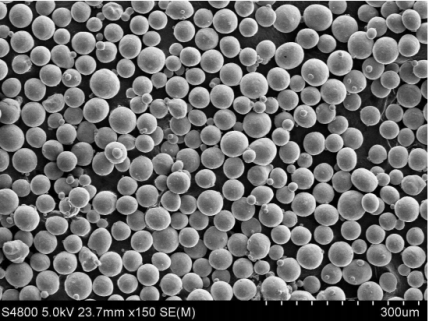Table of Contents
ToggleIntroduction
Inconel 600 is a popular nickel-chromium alloy known for its exceptional resistance to high temperatures and corrosion. It finds widespread applications in various industries due to its unique combination of properties. In recent years, the development of Inconel 600 powder has opened up new possibilities in additive manufacturing and other advanced manufacturing techniques. This article explores the properties, applications, manufacturing process, advantages, and challenges associated with Inconel 600 powder.
What is Inconel 600 Powder?
Inconel 600 powder is a fine, granular form of the Inconel 600 alloy. It is produced through a process called atomization, where molten Inconel 600 is rapidly cooled and solidified into small spherical particles. This powder form allows for greater flexibility in manufacturing processes, especially in additive manufacturing, also known as 3D printing.
Properties of Inconel 600 Powder
High Temperature Resistance
One of the remarkable properties of Inconel 600 powder is its ability to withstand high temperatures. It can retain its strength and structural integrity even at elevated temperatures up to 2000°F (1093°C). This makes it suitable for applications in extreme heat environments, such as gas turbines, aerospace engines, and heat treatment furnaces.
Corrosion Resistance
Inconel 600 powder exhibits excellent resistance to corrosion, particularly in environments containing acids, alkalines, and chloride ions. It can withstand the corrosive effects of various corrosive media, including sulfuric acid, hydrochloric acid, and seawater. This property makes it highly desirable in chemical processing plants and offshore industries.
Oxidation Resistance
Another notable property of Inconel 600 powder is its exceptional resistance to oxidation. It forms a protective oxide layer on its surface when exposed to high temperatures, which prevents further oxidation. This characteristic makes it suitable for applications in gas turbines, combustion chambers, and other high-temperature environments where oxidation can occur.

Applications of Inconel 600 Powder
Inconel 600 powder finds extensive applications across different industries. Some of the prominent applications include:
Aerospace Industry
Inconel 600 powder is widely used in the aerospace industry for manufacturing components such as turbine blades, combustor liners, and exhaust systems. Its high temperature and corrosion resistance, coupled with excellent mechanical properties, make it an ideal choice for demanding aerospace applications.
Chemical Processing
In chemical processing plants, where exposure to corrosive chemicals is common, Inconel 600 powder is employed to fabricate equipment like heat exchangers, reaction vessels, and piping systems. Its resistance to corrosion and oxidation ensures the longevity and reliability of such equipment.
Nuclear Power Plants
Inconel 600 powder is extensively used in nuclear power plants due to its ability to withstand high levels of radiation and its corrosion resistance in nuclear environments. It is utilized in reactor components, fuel element spacers, and steam generator tubing, among other applications.
Heat Treatment Furnaces
Heat treatment furnaces require materials that can withstand extreme temperatures without losing their mechanical properties. Inconel 600 powder is commonly used for manufacturing furnace fixtures, heating elements, and baskets due to its excellent heat resistance and longevity in such harsh environments.
Manufacturing Process of Inconel 600 Powder
The production of Inconel 600 powder involves several steps:
Atomization
The first step in the manufacturing process is atomization. Molten Inconel 600 alloy is poured through a nozzle and subjected to high-pressure gas or water jets. This process breaks the molten metal into small droplets, which rapidly solidify into fine powder particles as they cool.
Spherical Powder Production
To achieve a more uniform powder shape, the atomized particles can undergo additional processing to produce spherical powder. This can involve techniques such as heat treatment, controlled solidification, and mechanical processing. Spherical powder particles have improved flowability and packing density, making them ideal for additive manufacturing processes.
Powder Characterization
Once the powder is produced, it undergoes characterization tests to determine its properties and quality. Particle size distribution, flowability, chemical composition, and morphology are some of the parameters evaluated during this stage. These tests ensure that the powder meets the required specifications for its intended applications.

Advantages of Using Inconel 600 Powder
Utilizing Inconel 600 powder in manufacturing processes offers several advantages:
Design Flexibility
The use of Inconel 600 powder in additive manufacturing allows for greater design flexibility. Complex geometries and intricate structures can be fabricated with ease, enabling the production of parts that would be challenging or impossible to manufacture using traditional methods.
Improved Efficiency
Inconel 600 powder enables the optimization of material usage, reducing waste and improving overall efficiency. Additive manufacturing techniques, such as selective laser melting (SLM) or electron beam melting (EBM), can produce parts with minimal material consumption, resulting in cost savings and reduced environmental impact.
Enhanced Product Performance
Components manufactured using Inconel 600 powder exhibit excellent mechanical properties, high strength, and good fatigue resistance. They can withstand extreme temperatures and harsh environments, ensuring superior performance and longevity compared to traditional manufacturing methods.
Challenges in Working with Inconel 600 Powder
While Inconel 600 powder offers numerous benefits, there are also challenges associated with its use:
High Cost
Inconel 600 powder is relatively expensive compared to other alloys and materials. The cost of raw materials, processing techniques, and quality control contribute to the higher price. This cost factor needs to be considered when selecting Inconel 600 powder for specific applications.
Machining Difficulties
Inconel 600 powder has high strength and work hardening characteristics, making it challenging to machine. Specialized machining techniques and tools are required to achieve the desired shape and dimensions. This can increase production time and costs, especially for complex components.
Powder Handling
Powder handling in additive manufacturing processes requires careful consideration. Inconel 600 powder is fine and easily airborne, posing health and safety risks if not managed properly. Strict safety protocols, including proper ventilation, dust control, and personal protective equipment, should be followed during powder handling operations.
Future Trends and Developments
The use of Inconel 600 powder in additive manufacturing is expected to grow in the coming years. Ongoing research and development efforts aim to further optimize the powder characteristics, such as particle size distribution, flowability, and alloy composition. These advancements will expand the range of applications and improve the overall performance of Inconel 600 powder-based components.

Conclusion
In conclusion, Inconel 600 powder is a highly versatile material with exceptional properties that make it suitable for a wide range of applications. Its high temperature resistance, corrosion resistance, and oxidation resistance make it an ideal choice for industries such as aerospace, chemical processing, nuclear power, and heat treatment. The manufacturing process of Inconel 600 powder involves atomization and can be further refined to produce spherical powder particles. The use of Inconel 600 powder offers advantages like design flexibility, improved efficiency, and enhanced product performance. However, there are challenges to consider, including the high cost, machining difficulties, and proper powder handling.
Looking ahead, the future of Inconel 600 powder holds promising developments. Ongoing research and advancements aim to optimize powder characteristics and expand its applications. As additive manufacturing continues to evolve, Inconel 600 powder will play a crucial role in pushing the boundaries of design and manufacturing possibilities.
FAQs
1. Is Inconel 600 powder only used in additive manufacturing?
No, while Inconel 600 powder is commonly used in additive manufacturing, it also finds applications in traditional manufacturing processes like casting and forging.
2. Can Inconel 600 powder be used in high-pressure and high-temperature environments?
Yes, Inconel 600 powder is specifically designed to withstand high temperatures and pressures, making it suitable for demanding environments.
3. Is Inconel 600 powder resistant to chemical corrosion?
Yes, Inconel 600 powder exhibits excellent resistance to corrosion in various chemical environments, including acids and alkalines.
4. Are there any alternative materials to Inconel 600 powder?
Yes, there are alternative nickel-based alloys and superalloys available, but Inconel 600 powder is favored for its unique combination of properties and performance.
5. Can Inconel 600 powder be recycled?
Yes, Inconel 600 powder can be recycled and reused in manufacturing processes, contributing to sustainability and cost-efficiency.






